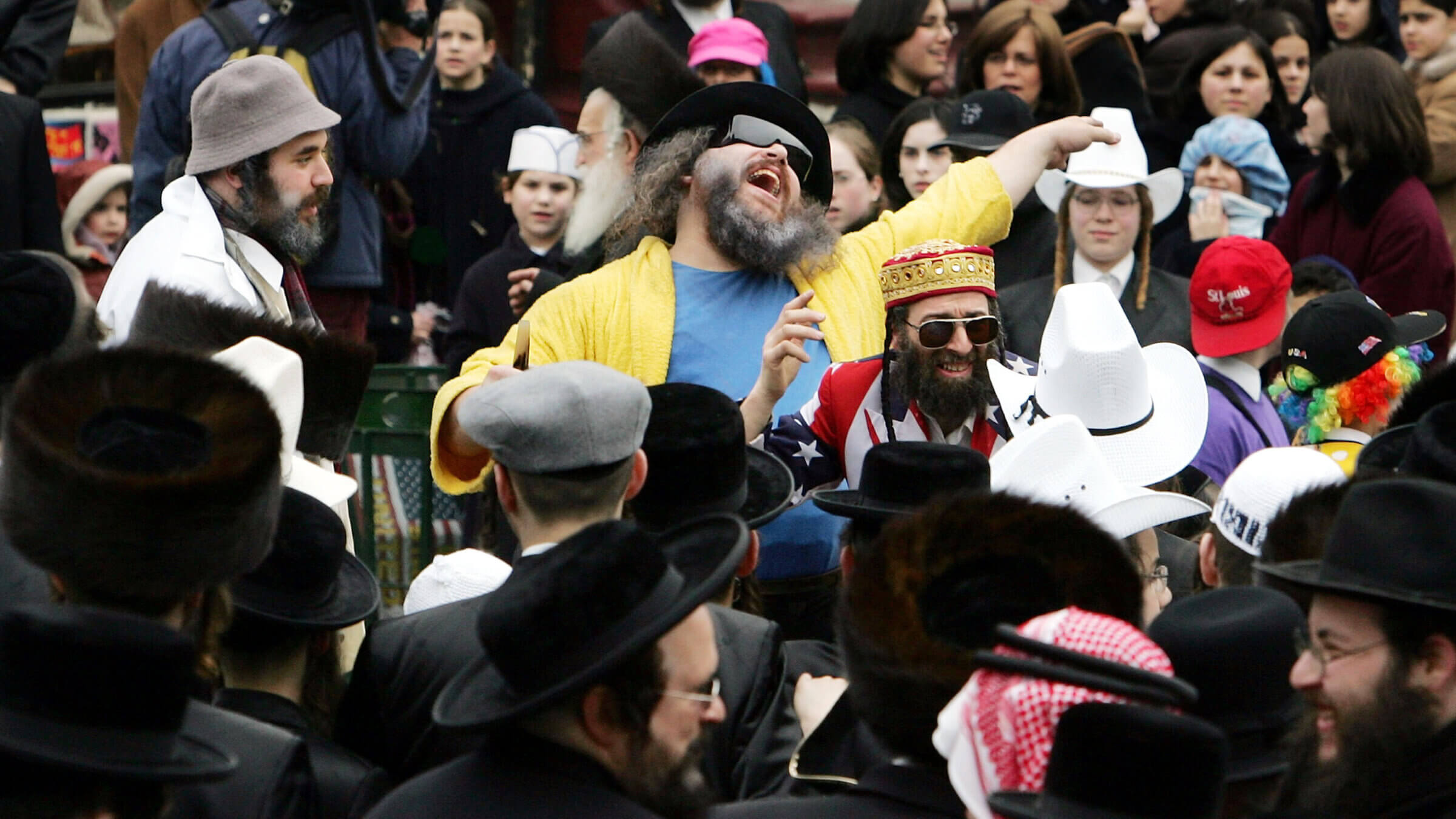You should probably be aware of that Purim song’s problematic backstory
It was made famous by Harry Belafonte and Johnny Cash. And at least one version included the N-word.

NEW YORK – MARCH 25: Jews dance in costumes and cowboy hats during Purim festivities in the Williamsburg section of Brooklyn in 2005. Photo by Mario Tama/Getty Images
Mishenichnas Adar, marbim b’simcha. When the month of Adar comes, joy increases., That’s a quote from the Talmud, and the refrain of a song popular for Purim, the joyous Jewish holiday celebrated on the 14th of the Hebrew month of Adar — this year, Saturday night and Sunday.
There are a few different tunes for it, and as is the case with many Jewish melodies, their origins are often unknown by the people who sing them.
So someone who has danced to this song may be surprised to learn that one of those tunes comes from “Pick A Bale of Cotton,” a once-popular folk song of African American origin that became controversial in the latter half of the 20th century. Among the reasons: One version of the English lyrics included the N-word.
Eli Green, who runs a YouTube channel called Jewish Music Toronto, published a video raising concerns about the tune, noting that the next holiday on the Jewish calendar, Passover, is about freedom.
“We’re barely a month away from escaping slavery, and we’re singing this? Seriously?” he asks. “Whatever you do, don’t sing this version of ‘Mishenichnas Adar.’”
“Pick a Bale” was first recorded in 1933 by Black prison workers in Texas. It was included in the 1934 anthology American Ballads and Folk Songs compiled by music archivist John Lomax, and came to popularity following a 1940s recording by the Black folk singer Lead Belly.
The ditty became even more widely known during the 1950s and 1960s, when it was separately recorded by Harry Belafonte and Johnny Cash.
But the lyrics later drew scrutiny for the way they seemed to poke fun at slavery:
Gonna jump down, turn around, pick a bale of cotton (The Purim version: Mi-she, mi-she, mishenichnas Adar)
Gonna jump down, turn around, pick a bale a day (Mar-bin, mar-bin, marbin b’simcha)
Oh, lordie! Pick a bale of cotton (Oh, oh, oh, mishenichnas adar)
Oh, lordie! Pick a bale a day (Oh, 0h, oh, marbim b’simcha)
There is some debate as to whether it was originally a Black slave song or a Black prison camp song, but nowadays it is widely considered offensive.
“People shouldn’t have to be subjected to this, especially our children,” one NAACP leader said after the song was included in a suburban Detroit school’s folk music choir’s program.
When Jews started singing “Mishenichnas Adar” to the “Pick A Bale” tune — and whose idea it was — is probably lost to time. Perhaps it crossed over in the 1940s, when Jews were active in the New York folk scene; or maybe it only happened after Cash sang it in 1962. But the phenomenon that produced it, called contrafactum, is ubiquitous in Jewish music.
Gordon Dale, a professor of Jewish musicology at Hebrew Union College–Jewish Institute of Religion, defined contrafactum as “taking one melody and applying it to another set of words.” Like “Maoz Tzur,” a Hanukkah song that employs a German folk melody, but also like your synagogue’s Beatles-themed Kabbalat Shabbat or ever-changing tunes for “Adon Olam.”
Given the popularity of “Pick a Bale” in the American folk music scene, Dale said, “it makes sense that many Jews would have gotten to know it,” and “when you pair that with the common practice of contrafactum, it’s not so surprising that those two worlds would meet.”
Dale said locating the smoking gun of musical appropriation can be difficult when it comes to Jewish music, however, which tends to originate outside of the recording studio. (Not always: We know, for example, that Lubavitchers’ use of “La Marseillaise” for a Yom Kippur hymn began in 1973 with the Lubavitcher Rebbe himself.)
One possibility, Dale said, was that religious school teachers used “Pick A Bale” to help young children learn the words using a familiar tune. “I would think that the application of this melody to this text has more to do with how well the words fit,” he said, than the song’s major key.
Even without knowing the original Jewish “Pick a Bale” crossover artist, Dale said the use of the tune can teach us about the generations of American Jews who made it a fixture of the Purim season.
“What it does tell is something about the exposure that American Jews had to this form of music,” he explained, “about how these Southern labor songs were being popularized and used by American youth, and how American Jews were very much a part of that.
“So this was not an instance of separatism,” Dale continued. “It was using the music of American youth culture in a Jewish space.”
Today, the “Mishenichnas” tune is so far removed from its secular parent that Hasidic artists have adopted it. Dale said he wouldn’t feel comfortable using the tune in a Jewish setting today. There are other “Mishenichnas Adar” melodies to choose from, like this one, whose musical provenance is unclear. (At least to me.)
“But I also know that it’s very, very common in the American Jewish soundscape,” he said, “and many people don’t know where it’s from.”
Now you do.
















